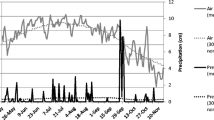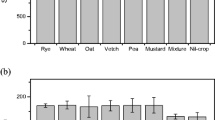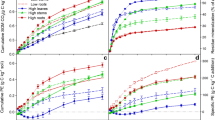Abstract
Cover crop (CC) decomposition and subsequent release of nitrogen (N) are highly influenced by residue water potential (ψ) and temperature (T). To evaluate how carbon (C) and N mineralization from surface-applied CC residues responds to changes in ψ and T, a controlled microcosm experiment was conducted for 150 days with three CC residues (early-killed cereal rye (Secale cereale L.), late-killed cereal rye, late-killed crimson clover (Trifolium incarnatum L.), and a soil-alone control) under different ψ (−0.03, −1.5, −5, and −10 MPa) and T (15, 25, and 35 °C) conditions. Headspace gas was sampled periodically to determine carbon dioxide (CO2) and nitrous oxide (N2O) emissions. Soil inorganic N was determined by destructive sampling at 15, 30, 60, 100, and 150 days. Temporal dynamics in C and N mineralization from surface-applied CC residues were adequately described by first-order rate kinetic models. Early-killed rye and crimson clover (low C:N) residues decomposed quickly and mineralized N, whereas, late-killed rye residue (high fiber content and C:N) immobilized N. The normalized values of C and N mineralized from surface-applied CC residues increased exponentially with increasing ψ from −10.0 to −0.03 MPa. Increasing T from 15 to 35 °C further amplified the effect of ψ, suggesting a strong interactive effect of ψ and T on C and N mineralization from CC residues. Mathematical equations were developed to describe these interactive effects. Existing computer simulation models (e.g., CERES-N) could be improved by integrating these equations to simulate the effect of environmental conditions on surface-applied CC residue decomposition and N mineralization.





Similar content being viewed by others
Abbreviations
- CC:
-
Cover crops
- θ g :
-
Gravimetric water content
- ψ :
-
Water potential
- T :
-
Temperature
- MTRF:
-
Moisture-temperature reduction factor
- k values:
-
Decay rate constants
References
Alonso-Ayuso M, Gabriel JL, Quemada M (2014) The kill date as a management tool for cover cropping success. PLoS One 9(10):e109587–e109e12. https://doi.org/10.1371/journal.pone.0109587
Cabrera ML, Kissel DE, Vigil MF (2005) Nitrogen mineralization from organic residues: research opportunities. J Environ Qual 34:75–79
Calcium chloride handbook (2003) A guide to properties, forms, storage and handling. The Dow Chemical Company. 2003
Coppens F, Garnier P, De Gryze S, Merckx R, Recous S (2006) Soil moisture, carbon and nitrogen dynamics following incorporation and surface application of labelled crop residues in soil columns. Eur J Soil Sci 57:894–905
Coppens F, Garnier P, Findeling A, Merckx R, Recous S (2007) Decomposition of mulched vs. incorporated crop residues: modelling with PASTIS clarifies interactions between residue quality and location. Soil Biol Biochem 39:2339–2350. https://doi.org/10.1016/j.soilbio.2007.04.005
Findeling A, Garnier P, Coppens F, Lafolie F, Recous S (2007) Modelling water, carbon, and nitrogen dynamics in soil covered with decomposing mulch. Eur J Soil Sci 58:196–206
Frankenberger WT Jr, Abdelmagid HM (1985) Kinetic parameters of nitrogen mineralization rates of leguminous crops incorporated into soil. Plant Soil 87:257–271
Frey SD, Elliott ET, Paustian K, Peterson GA (2000) Fungal translocation as a mechanism for soil nitrogen inputs to surface residue decomposition in no-tillage agroecosystem. Soil Biol Biochem 32:689–698
Gaskin JW, Cabrera ML, Kissel DE, Hitchcock R (2019) Using the cover crop N calculator for adaptive nitrogen fertilizer management: a proof of concept. Renew Agric Food Syst 35:1–11. https://doi.org/10.1017/S1742170519000152
Grant RF, Juma NG, McGill WB (1993) Simulation of carbon and nitrogen transformations in soil: mineralization. Soil Biol Biochem 25:1317–1329
Griffin DM (1977) Water potential and wood-decay fungi. Annual Review of Phytopathology 15:319–329
Griffin DM (1981) Water and microbial stress. Adv Microb Ecol 5:91–136
Holland EA, Coleman DC (1987) Litter placement effects on microbial and organic matter dynamics in an agroecosystem. Ecology 68:425–433
Joshi DR, Clay DE, Clay SA, Smart AJ (2019) Seasonal losses of surface litter in northern great plains mixed-grass prairies. Rangeland Ecol Manag 73:259–264
Kuo S, Sainju UM (1998) Nitrogen mineralization and availability of mixed leguminous and non-leguminous cover crop residues in soil. Biol Fert Soils 26:346–353
Kuo S, Sainju UM, Jellum EJ (1997) Winter cover cropping influence on nitrogen in soil. Soil Sci Soc Am J 61:1392–1399
Lawson A, Fortuna AM, Cogger C, Bary A, Stubbs T (2013) Nitrogen contribution of rye–hairy vetch cover crop mixtures to organically grown sweet corn. Renew Agric Food Syst 28(01):59–69. https://doi.org/10.1017/S1742170512000014
Ligges U, Mächler M (2003) Scatterplot3d-an R package for visualizing multivariate data. J Stat Softw 8:1–20
Manzoni S, Schimel JP, Porporato A (2012) Responses of soil microbial communities to water stress: results from a meta-analysis. Ecology 93:930e938
McGill WB, Hunt HW, Woodmansee RG, Reuss JO (1981) Phoenix-a model of the dynamics of carbon and nitrogen in grassland soils. In: Clark FE, Rosswall T (eds) Terrestrial nitrogen cycles, Ecol Bull (Stockholm), vol 33, pp 49–115
Melkonian J, Poffenbarger HJ, Mirsky SB, Ryan MR, MoebiusClune BN (2017) Estimating nitrogen mineralization from cover crop mixtures using the precision nitrogen management model. Agron J 109:1944–1959
Mendiburu FD (2019) Agricolae: statistical procedures for agricultural research. R Package Version 1:3–1. http://CRAN.R-project.org/package=agricolae
Mirsky SB, Spargo JT, Curran WS, Reberg-Horton SC, Ryan MR, Schomberg HH, Ackroyd VJ (2017) Characterizing cereal rye biomass and allometric relationships across a range of fall available nitrogen rates in the Eastern United States. Agron J 109:1520–1531
Molina JE, Clapp CE, Schaeffer MJ, Chichester FW, Larson W (1983) NCSOIL, a model of nitrogen and carbon transformation in soil: description, calibration and behaviour. Soil Sci Soc Am J 47:85–91
Moore AM (1986) Temperature and moisture dependence of decomposition rates of hardwood and coniferous leaf litter. Soil Biol Biochem 18:427–435
Moyano FE, Manzoni S, Chenu C (2013) Responses of soil heterotrophic respiration to moisture availability: an exploration of processes and models. Soil Biol Biochem 59:72–85
Nicolardot B, Bouziri L, Bastian F, Ranjard L (2007) A microcosm experiment to evaluate the influence of location and quality of plant residues on residue decomposition and genetic structure of soil microbial communities. Soil Biol Biochem 39:1631–1644
Otte B, Mirsky S, Schomberg H, Davis B, Tully K (2019) Effect of cover crop termination timing on pools and fluxes of inorganic nitrogen in no-till corn. Agron J 111:2832–2842. https://doi.org/10.2134/agronj2018.10.0699
Paustian K, Bonde TA (1987) Interpreting incubation data on nitrogen mineralization from soil organic matter. In: Cooley JH (ed) Soil organic matter dynamics and soil productivity. Proceedings of INTECOL workshop, Athens, GA, pp 101–112
Pinheiro J, Bates D, DebRoy S, Sarkar D (2017) nlme: linear and nonlinear mixed effects models. R package version 3.1-131. R Found Stat Comput, Vienna.
Poffenbarger HJ, Mirsky SB, Weil RR, Kramer M, Spargo JT, Cavigelli MA (2015) Legume proportion, poultry litter, and tillage effects on cover crop decomposition. Agron J 107(6):2083–2096. https://doi.org/10.2134/agronj15.0065
Quemada M, Cabrera ML (1995) CERES-N model predictions of nitrogen mineralized from cover crop residues. Soil Sci Soc Am J 59:1059–1065. https://doi.org/10.2136/sssaj1995.03615995005900040015x
Quemada M, Cabrera ML (1997) Temperature and moisture effects on C and N mineralization from surface applied clover residue. Plant Soil 189:127–137
Quemada M, Cabrera ML, McCracken DV (1997) Nitrogen release from surface-applied cover crop residues: evaluating the CERES-N submodel. Agron J 89:723–729. https://doi.org/10.2134/agronj1997.00021962008900050003x
Reberg-Horton SC, Grossman JM, Kornecki TS, Meijer AD (2012) Utilizing cover crop mulches to reduce tillage in organic systems in the southeastern USA. Renew Agric Food Syst 27:41–48. https://doi.org/10.1017/S1742170511000469
Roper MM (1985) Straw decomposition and nitrogenase activity (C2H2 reduction): effects of soil moisture and temperature. Soil Biol Biochem 17(1):65–71
Schjonning P, Thomsen IK, Moldrup P, Christensen BT (2003) Linking soil microbial activity to water- and air-phase contents and diffusivities. Soil Sci Soc Am Jl 67:156–165
Schomberg HH, Cabrera ML (2001) Modeling in situ N mineralization in conservation tillage fields: comparison of two versions of the CERES nitrogen submodel. Ecol Modell 145:1–15. https://doi.org/10.1016/S0304-3800(01)00379-9
Schomberg HH, Ford PB, Hargrove WL (1994) Influence of crop residues on nutrient cycling and soil chemical properties. In: Unger PW (ed) Managing agricultural residues. Lewis Publishers, Boca Raton, FL, pp 99–121
Skopp J, Jawson MD, Doran JW (1990) Steady-state aerobic microbial activity as a function of soil-water content. Soil Sci Soc Am J 54:1619–1625
Soil Survey Staff (2020) Natural Resources Conservation Service, United States Department of Agriculture. Web Soil Survey. Available online at the following link: https://websoilsurvey.sc.egov.usda.gov/. Accessed [1/2/2020].
Stark J, Firestone M (1995) Mechanisms for soil moisture effects on activity of nitrifying bacteria. Appl Environ Microbiol 61:218–221
Stott DE, Elliott LF, Papendick RI, Campbell GS (1986) Low temperature or low water effects on microbial decomposition of wheat residue. Soil Biol Biochem 18(6):577–582
Thapa R, Chatterjee A, Johnson JMF, Awale R (2015) Stabilized nitrogen fertilizers and application rate influence nitrogen losses under rainfed spring wheat. Agron J 107:1885–1894. https://doi.org/10.2134/agronj15.0081
Thapa R, Mirsky SB, Tully KL (2018a) Cover crops reduce nitrate leaching in agroecosystems: a global meta-analysis. J Environ Qual. 47(6):1400–1411. https://doi.org/10.2134/jeq2018.03.0107
Thapa R, Poffenbarger H, Tully KL, Ackroyd V, Kramer M, Mirsky SB (2018b) Biomass production and nitrogen accumulation by hairy vetch–cereal rye mixtures: a meta-analysis. Agron J 110:1197–1208. https://doi.org/10.2134/agronj2017.09.054
Thapa R, Tully KL, Cabrera ML, Dann C, Schomberg HH, Timlin D, Gaskin J, Reberg-Horton C, Mirsky SB (unpublished) Cover crop moisture content controls diurnal variations in surface residue decomposition
Thorburn PJ, Probert ME, Robertson FA (2001) Modelling decomposition of sugar cane surface residues with APSIM-Residue. Field Crops Res 70:223–232
Verberne ELJ, Hassink J, De Willigen P, Groot JJR, van Veen JA (1990) Modelling organic matter dynamics in different soils. Neth J Agr Sci 38:221–238
Vigil MF, Kissel DE (1991) Equations for estimating the amount of nitrogen mineralized from crop residues. Soil Sci Soc Am J 55:757–761
Wagger MG (1989) Time of desiccation effects on plant composition and subsequent Nitrogen release from several winter annual cover crops. Agron J 81:236–241
Wagger MG, Cabrera ML, Ranells NN (1998) Nitrogen and carbon cycling in relation to cover crop residue quality. J Soil Water Conserv 53:214–218
Wang WJ, Smith CJ, Chen D (2003) Towards a standardized procedure for determining the potentially mineralisable nitrogen of soil. Biol Fertil Soils 37:362–374
Wells MS, Reberg-Horton SC, Mirsky SB, Maul JE, Hu S (2017) In situ validation of fungal N translocation to cereal rye mulches under no-till soybean production. Plant Soil. 410:153–165
Williams A, Wells MS, Dickey DA, Hu S, Maul J, Raskin DT, Reberg-Horton SC, Mirsky SB (2018) Establishing the relationship of soil nitrogen immobilization to cereal rye residues in a mulched system. Plant Soil. 426:95–107
Woodruff LK, Kissel DE, Cabrera ML, Hitchcock R, Gaskin J, Vigil M, Sonon L, Saha U, Habteselassie MY, Rema J (2018) A web-based model of N mineralization from cover crop residue decomposition. Soil Sci Soc Am J 82:983–993
Yanni SF, Diochon A, Helgason BL, Ellert BH, Gregorich EG (2018) Temperature response of plant residue and soil organic matter decomposition in soil from different depths. Eur J Soil Sci 69:325–335. https://doi.org/10.1111/ejss.12508
Zadoks JC, Chang TT, Konzak CF (1974) A decimal code for the growth stages of cereals. Weed Res 14:415–421. https://doi.org/10.1111/j.1365-3180.1974.tb01084.x
Acknowledgements
We express our sincere thanks to the research interns and technical staff of the Sustainable Agricultural Systems Laboratory, USDA-ARS, Beltsville Agricultural Research Center, Beltsville, MD for their laboratory assistance.
Availability of data and material
Raw data will be made available upon request.
Code availability
R codes used for data analysis will be made available upon request.
Funding
This research is part of a regional collaborative project supported by the USDA Natural Resources Conservation Services (Conservation Innovation Grant # 8042-21660-004-36-R), USDA National Institute of Food and Agriculture (Award # 2018-68011-28372), and the Northeast Sustainable Agriculture Research and Education (SARE) graduate student grant (Award # GNE17-160-31064).
Author information
Authors and Affiliations
Corresponding author
Ethics declarations
Ethics approval
Not applicable.
Consent to participate
Not applicable.
Consent for publication
All authors have approved the manuscript in its entirety and agreed for its publication.
Conflict of interest
The authors declare no competing interests.
Additional information
Publisher’s note
Springer Nature remains neutral with regard to jurisdictional claims in published maps and institutional affiliations.
Highlights
• First-order rate kinetic models adequately described C and N mineralization.
• Net N immobilization was observed in late-killed rye residue.
• Increasing temperature (T) enhanced water potential (ψ) effect on C and N mineralization.
• C and N mineralized increased exponentially with increasing ψ from −10.0 to −0.03 MPa.
• Mathematical equations were developed to describe ψ and T interactive effects.
Supplementary information
ESM 1
(DOCX 1074 kb)
Rights and permissions
About this article
Cite this article
Thapa, R., Tully, K.L., Cabrera, M.L. et al. Effects of moisture and temperature on C and N mineralization from surface-applied cover crop residues. Biol Fertil Soils 57, 485–498 (2021). https://doi.org/10.1007/s00374-021-01543-7
Received:
Revised:
Accepted:
Published:
Issue Date:
DOI: https://doi.org/10.1007/s00374-021-01543-7




